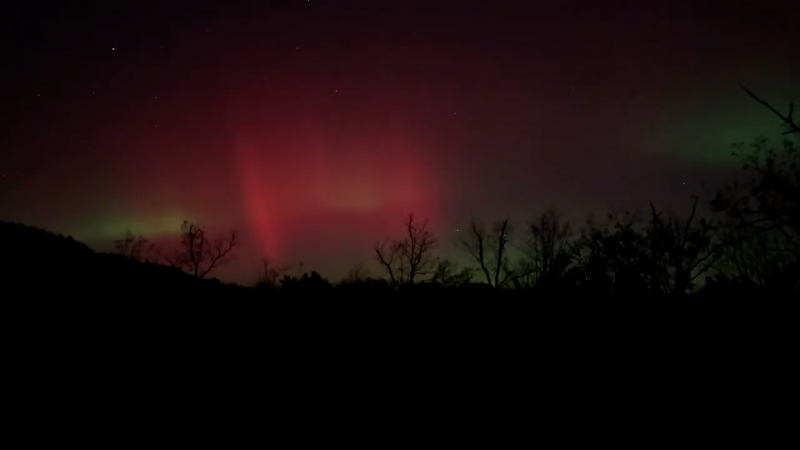
Northern Lights shine in the sky across much of the US
Thanks to the strongest solar flare of 2025, the Northern Lights were visible to southern parts of the U.S., creating a stunning display in the sky.
The sun unleashed the biggest solar flare of 2025, triggering solar storm warnings this week with the northern lights visible in New Jersey, and even Alabama and California. Tonight, Nov. 13, a storm watch for a G3 geomagnetic storm has been issued by NOAA’s Space Weather Prediction Center, meaning another possible chance to see the colors of the aurora borealis tonight.
NOAA predicts the solar storm will be strong tonight, Nov. 13, and minor on Nov. 14. And with “no chance” the northern lights will be visible in the U.S. on Saturday, Nov. 15, now’s the time to grab your iPhone, adjust the settings and take iconic photos.
The eruption from sunspot AR4274, an X5.1 solar flare, released a coronal mass ejection (CME) at massive speeds toward Earth, hitting midday Nov. 12. Solar flares don’t harm humans’ health, but can disrupt technology, GPS, power grids, radio communications, according to NASA. The flare is the strongest since October 2024 when the northern lights were widely visible over New Jersey.
While the timing of the aurora borealis, or northern lights, can be tricky and unpredictable, here’s what we know.
Are the northern lights visible tonight? Map
The northern lights forecast for a G3 solar storm shows the states have the best chance to view the aurora tonight, Nov. 13, according to the NOAA aurora forecast map. Since weather, timing and orientation is considered, NOAA says predicting the northern lights’ intensity is tough, meaning New Jersey could still be within sight of the lights tonight. These are states within view:
MaineMichiganWisconsinMinnesotaNorth DakotaSouth DakotaMontanaIdahoWashingtonAlaska
However, a G3 “strong” storm with a Kp index of 6 or higher, which is the current forecast, means the following states are in the view line of the northern lights:
PennsylvaniaNew YorkOhioVermontMassachusettsNew HampshireIndianaIowaNebraskaWyomingOregonWhat time can I see the northern lights tonight?
The northern lights are best viewed between 10 p.m. and 2 p.m., NOAA said. You cannot view the aurora borealis during the day. NOAA’s Space Weather 3-Day Forecast says the best times to view the lights.
How to see the northern lights
Dark skies make for better northern lights viewing. Typically, you can’t view the northern lights with the naked eye in New Jersey, so your best way to see the northern lights is by using your iPhone or high-quality cell phone with “night mode.”
Grab a coat, head outside and while you cannot see the pink swirls, point your cell phone to the sky with a steady hand and shoot away! A tried-and-true method is to ensure your phone camera is on long-exposure mode (dark mode) and use a tripod and a timer to take the photo. Night mode tends to cause blurry photos if not taken with a steady hand.
Also consider where you are, particularly in NYC and city areas with light pollution. Check out a local park without artificial lights and be sure to check your local weather forecast. Clouds may just disrupt the entire show.
Where to check northern lights forecast
NOAA’s Aurora Forecast map produces real-time updates every 30 minutes. Here’s some other websites to check out:
Best apps for northern lights forecast
There are several iPhone and Samsung phone apps you can download to check the northern lights forecast for free. Here are a few:
What are the northern lights?
The northern lights, or aurora borealis, are the result of electrically charged particles from the Sun and gases in Earth’s outer atmosphere known for creating ribbons of colorful light in the night sky, often shades of green, red or purple.
The sun is currently at its maximum height of the 11-year solar cycle, which triggers electromagnetic activity, according to NASA. While we see the famous display as a striking sight, these solar eruptions bring potential impacts to power grids, satellite signals, radio communications, navigation and GPS, depending on their strength according to NOAA.
Lori Comstock is a New Jersey-based journalist with the Mid-Atlantic Connect Team.
